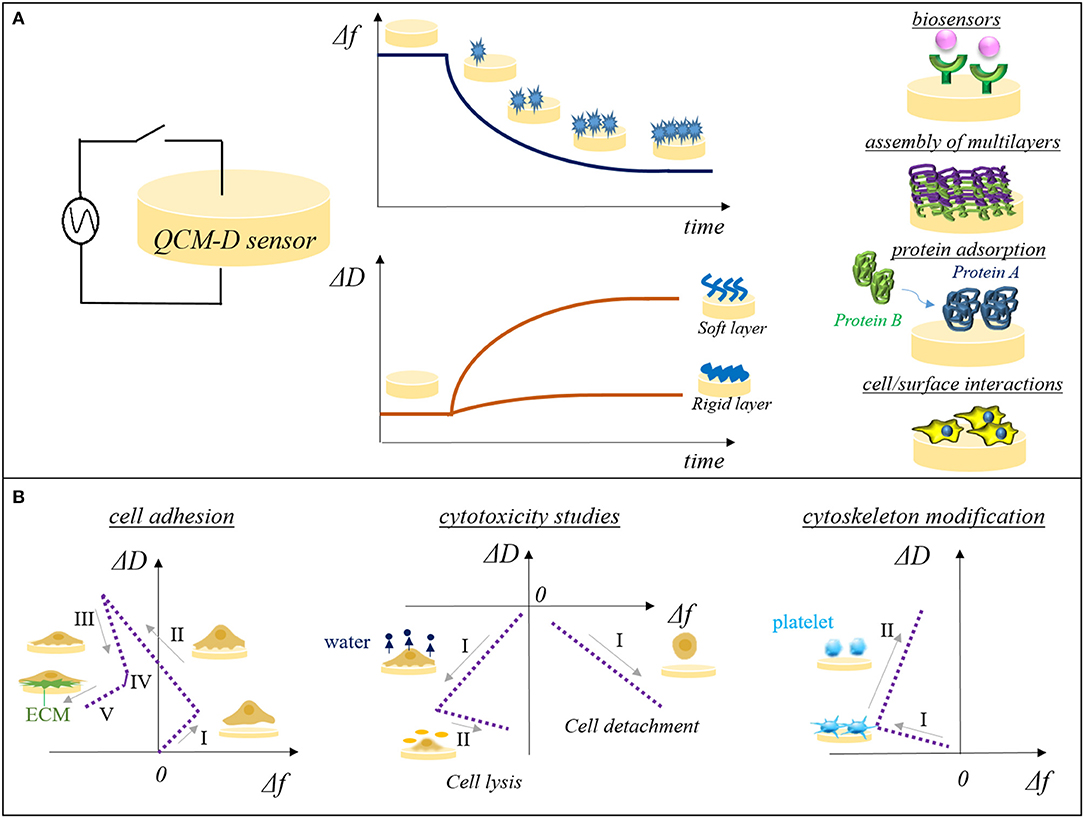Quartz Crystal Microbalance with Dissipation Monitoring (QCM-D) Service
- Frequency shifts (Δf) are proportional to the mass of molecules attached to the sensor surface and reflect adsorption or desorption processes.
- Dissipation shifts (ΔD) indicate the energy loss of oscillation and describe structural features of molecular layers such as rigidity or flexibility.
Quartz Crystal Microbalance with Dissipation Monitoring (QCM-D) is a highly sensitive technique for surface analysis that enables real-time, label-free monitoring of adsorption, desorption, and molecular interactions on solid surfaces. In addition to measuring mass changes, QCM-D provides dissipation parameters that reveal structural information such as stiffness, viscoelasticity, and conformational transitions at interfaces. With nanogram-level sensitivity and powerful kinetic resolution, this method has become widely applied in biomedicine, materials science, nanotechnology, the food industry, and environmental research.
MtoZ Biolabs offers Quartz Crystal Microbalance with Dissipation Monitoring (QCM-D) Service supported by advanced instrumentation and specialized data analysis. We provide a comprehensive solution that spans experimental design, sample preparation, and data interpretation, helping clients gain insights into interfacial molecular dynamics and structural properties with reliable and reproducible results.
Technical Principles
The principle of QCM-D is based on the resonant oscillation of quartz crystals under an electric field.
By simultaneously monitoring both Δf and ΔD, Quartz Crystal Microbalance with Dissipation Monitoring (QCM-D) Service allows researchers to detect not only mass changes but also viscoelastic and structural properties of interfacial layers, offering a more complete view of interfacial processes.

Tonda-Turo, C. et al. Front. Bioeng. Biotechnol. 2018.
Figure 1. Principles and Applications of QCM-D
Analysis Workflow
MtoZ Biolabs has established a standardized workflow to ensure accuracy and reproducibility:
1. Experimental Design: Select sensor substrates, buffers, and operating conditions according to project objectives.
2. Sample Preparation: Optimize solutions or surface modifications to ensure binding specificity and signal stability.
3. Real-time Monitoring: Record frequency and dissipation shifts to track molecular binding, release, or conformational transitions.
4. Temperature Control: Perform experiments under physiologically relevant conditions to increase biological significance.
5. Data Modeling: Use multilayer and viscoelastic models to extract kinetic and interfacial parameters.
6. Result Delivery: Provide complete data sets, fitted curves, and professional reports with interpretation
Why Choose MtoZ Biolabs?
✔ Advanced Analysis Platform: Equipped with high-performance QCM-D systems to ensure accurate and reproducible results.
✔ Expert Scientific Team: Experienced researchers provide experimental optimization, data modeling, and in-depth interpretation.
✔ Customized Workflows: Flexible design of experimental protocols tailored to specific projects, from biomolecules to cells and material studies.
✔ One-Time-Charge: Our pricing is transparent, no hidden fees or additional costs.
Sample Submission Suggestions
Our Quartz Crystal Microbalance with Dissipation Monitoring (QCM-D) Service accepts a broad range of samples including DNA, RNA, proteins, peptides, liposomes, cells, polymers, and coating materials. Liquid samples should be transported under cold chain, while solid and polymer samples can be shipped at room temperature. Clients are encouraged to provide research objectives and background information so that conditions can be optimized. Detailed submission guidelines are available upon request.
Applications
· Membrane Proteins and Lipids: Study adsorption and mobility of membrane components.
· Protein Interactions: Investigate the dynamics of antigen and antibody or receptor and ligand binding.
· Cell Adhesion and Toxicity: Monitor cell–substrate interactions and damage processes in real time.
· Drug Development: Assess binding stability and dissociation kinetics of candidate compounds.
· Materials Science: Characterize the interfacial properties of polymers, hydrogels, and nanostructures.
FAQ
Q1: What is the difference between QCM-D and SPR?
Both QCM-D and Surface Plasmon Resonance (SPR) are label-free and real-time detection methods. QCM-D provides mass and viscoelastic information, while SPR focuses on binding kinetics. The two techniques are complementary and can be combined for a more comprehensive analysis.
Q2: Can experiments be carried out under physiological conditions?
Yes. Our QCM-D systems are equipped with temperature control, allowing experiments at conditions close to physiological temperature and buffers, thereby ensuring biologically relevant results.
QCM-D technology enables simultaneous acquisition of mass and structural parameters within a single experiment, providing accurate data for studying molecular interactions, interfacial dynamics, and material properties. MtoZ Biolabs is dedicated to delivering high-quality and reproducible QCM-D solutions that transform research into reliable scientific findings and industrial value. Contact us to learn how our QCM-D service can accelerate your research and development.
Related Services
How to order?







